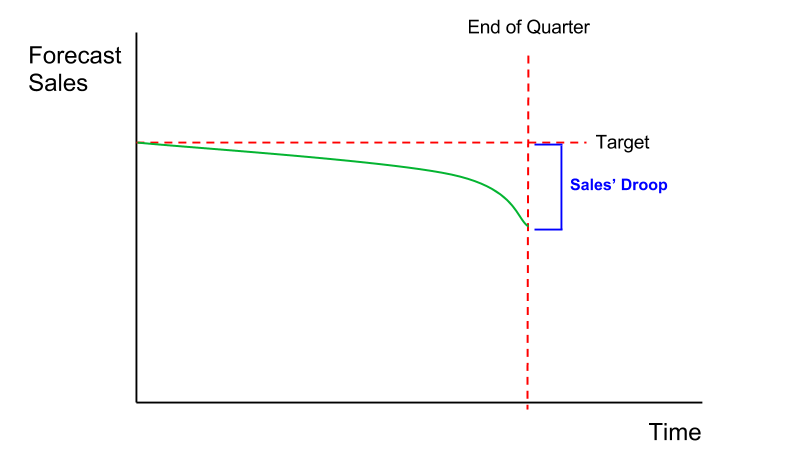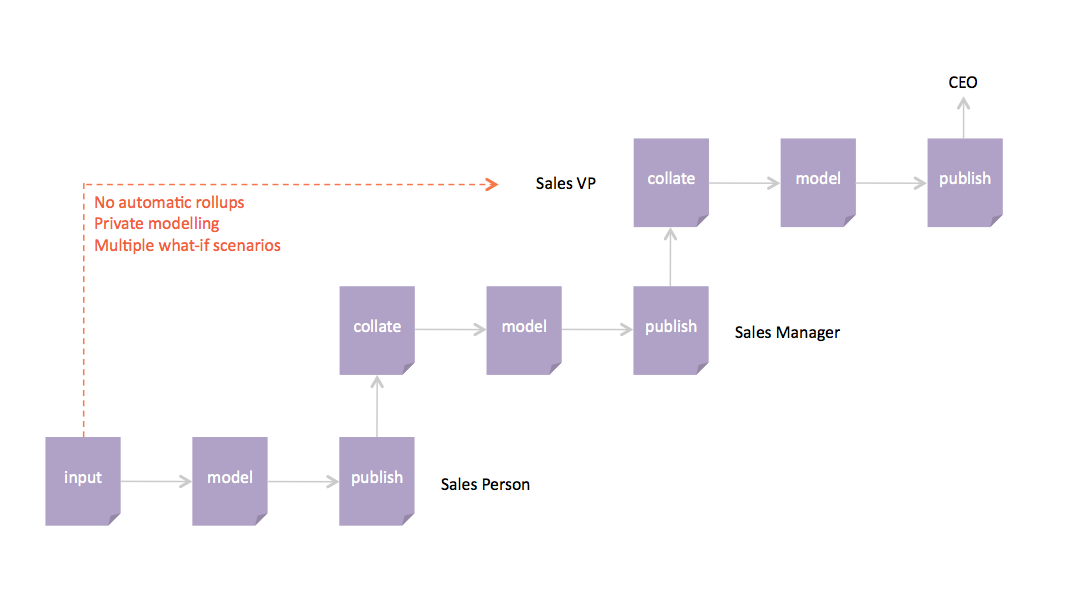An embarrassing problem not often publicly aired, this condition affects not just middle-aged salesmen, but younger guys too. And not just guys, but gals too are equally susceptible to this ailment. Seemingly firm for much of the time, everything suddenly goes
limp at the very end. Secondary effects include severe stomach ulcers in management.
At the beginning of the quarter, the forecast always looks rosy. Like a new-born baby, you can only envisage a bright and happy future, full of exceeded goals. But then the baby grows up. Slowly at first, imperfections begin to appear in the forecast as “surprise internal reorganizations in the prospect” cause deals to fall out (if it happens every quarter, why is it a surprise?) As the end of quarter nears, this decline accelerates, often resulting in a precipitous collapse two weeks before the bell.
Some managers shrug their shoulders, looking at forecasting as more of a process to help prioritize focus and move deals forward. After being burnt just too many times, they now downgrade their own team’s forecasts by what they consider a prudent amount depending on the optimism of the individual sales person, before passing up the management chain.
To understand how sales’ droop occurs, we need to look at sales psychology. Sales people are paid more than anyone else. A lot more. But they also have pretty much the least secure tenure of any white collar worker and can be (and are) fired at whim. Submitting a forecast of less than (say) 70% of goal is really just another way of resigning. Regardless of what you actually think, you’re far better off postponing the agony at least until the end of quarter. After all, who knows what might happen to save your skin – you may not turn out to be the slowest gazelle after all. Keep stum and keep smiling. It’s one more mortgage payment at least.
There is an opposite but rarer problem with sandbagging. Sales people have little incentive to forecast more than 130% of goal. If they do, then two things happen.
- Success has many fathers, so everyone in management will want to “help”. Since sales people typically regard management assistance as something worse than root canal treatment, they will seek to avoid this.
- The territory will get split. Especially in growing companies, where it is an inevitable byproduct. It may be in the best interest of the company to have two sales people pull in and share $2M, but the incumbent sales person would rather be left alone to scrape by with $1.5M on their own account.
The net is that the forecast is constrained to sit somewhere around the target. Evolution dictates that companies that still exist must have found a way around this, and usually it’s because the sandbaggers counterbalance the BS-ers. Management do their best to try to buffer this, and by the time the forecast reaches the CEO, it might have some semblance of reasonableness. But it’s still a forecast built on sand. In most cases just saying we’re going to do the same as last quarter +5%/-2% would be just as accurate, and a lot easier to arrive at.
Forecasting being subject to Murphy’s law, 99% of Sales Forecasting surprises involve missing the target, rather than over-achieving. It would be good to do better than this.
There are some things you can do to try and mitigate these factors.
We need to accept that there is no “single version of the truth”.
Forecasting represents opinion, not fact. Some opinions are best kept private, so we support multiple, private what-if scenario modelling. The flat reality is that we don’t really know what is going to happen in any given deal. Sales people are often their own worst enemy in presenting their visibility and control of deals far more than they actually have. Culturally in sales, it’s hard to say “we don’t know” about a deal, even if that is the truth.
Contrary to popular belief, middle management do add value to the forecasting process.
If yours don’t, then you need new ones. Sales managers will know their team and their innate disposition to optimism or pessimism. Since sales managers are usually also the most experienced sales people in the team, they can also bring their wisdom and insight to pattern match on deals that don’t quite smell right. SalesSeek automatically aggregates the team’s individual forecasts into one single forecast, but again one that can be cloned and modified in what-if scenarios privately. The sales manager can then select the best one to flag up the management chain. This process repeats at each level in the sales hierarchy. Letting the CEO see the raw forecasts of individual sales people is unlikely to be enjoyable for either party. Tools that support such automatic roll-up, usually end being actively worked around as managers tell sales people to put in the numbers they think the CEO wants to hear. It’s like a parent asking a teenager what they’ve been up to when they were out till late. The truth is the last thing you’re going to get.
Everybody spends their energy making the number happen.
End of quarter is a curious mix of anxiety, despair and relief. In the days after the close, no one really wants to revisit that cocktail of emotions. Better to move on….and repeat the same mistakes in three months time. SalesSeek allows the sales managers to monitor forecasting performance over prior periods – the sales person’s droop is graphically charted to prove the point. It sets the scene for a mature conversation about breaking out of the habit. “Look, for the last four quarters, your result has been 20% less than your forecast was at the beginning. I’m sensing a pattern here. What say we skip the dance this time and just start out 20% lower and actually hit our forecast for once?”. It doesn’t need to be hammered home, just gently reminded.
I don’t need Stevenson screens, barometric pressure readings or weather balloons to tell you right now it’s probably raining in Manchester and is probably sunny in Palo Alto.
There are other ways to forecast.
- Pipeline Modeling. If you know your average sales cycle length, average selling price (ASP), and close ratio, then you should be able to predict the average future cash flow of every lead. For example, if I have a sales cycle of 79 days, an ASP of $11K, and a close ratio of 7%, then on average, every lead today, should generate $11K x 7% = $770 in 79 days time. Integrate that up over your prior new leads, and you can calculate another prediction of quarterly revenue, and one which can be extended into the future over several quarters by assuming a realistic rate of lead growth. No method is perfect, but this is at least another independent handle on future revenues. In the diagram shown here, this is the part in green. In this example, in Q2 the model seems to underestimate actual revenue, suggesting that as we look at the current quarter (Q3), we may end up somewhere between this pessimistic estimate and the optimistic forecast, which looking at Q1 and Q2, we’d expect to fall.
- Capacity Planning. Not exactly a revenue predictor (at least, not one I would place any store in), it is however, important to make sure sales capacity and lead generation are balanced. If you have too many leads than can be properly closed, you can lead to a situation where market share is being left on the table because of cherry picking, even though your individual sales people are smashing targets and queuing outside the Mercedes-Benz showroom. Conversely, have too many sales people and whilst the market share will be maximal as every little crumb is hoovered up, your staff morale and profitability will be at rock bottom. Good sales people typically don’t stay around to see how that pans out. It’s a difficult balancing act. By playing with headcount, ramp times and sales productivity (both actual and targeted), you can plan out the business 6-12 months out.
Just like weather forecasting, sales forecasting will always be imprecise. However, by accepting the realities of people’s motivations, we can take some pragmatic actions to help improve the process, and reduce stress all round. Sales is hard enough as it is.


